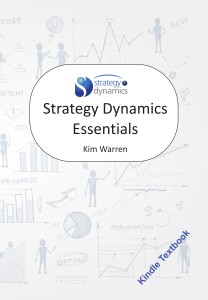Kim Warren on Strategy
Strategy insights and living business models
Simple strategy dynamics case example
Most of the corporate work I do on strategy can’t be made public, so here’s a small case from the non-profit sector that nevertheless demonstrates the principles of strategy dynamics. [It’s not just businesses that need strategy!]. Download the report at the end of the full post, but please read and appreciate the background before doing so. I am grateful to Andrew Daw and Doug Cowper, past and current UK presidents, for permission to make this report public.
The International Council on Systems Engineering is the professional community for SEs – the folk who use interdisciplinary methods to enable the realization of successful systems, such as large construction projects and defense contracts. The Council’s mission is “ .. to advance the state of the art and practice of systems engineering in industry, academia, and government by promoting interdisciplinary, scaleable approaches to produce technologically appropriate solutions that meet societal needs.”
The UK Chapter has about 700 members, and is growing strongly. It is poised to cross some important thresholds of scale and influence, which has important implications for strategy and resource needs in the next year or two.
In contrast with corporate situations, much more of what the strategy needs to address involves factors beyond the organization’s direct control – members, naturally, but also employers of SEs, Universities training them, and executives in organizations that might benefit from the work that SEs do – the Council itself has minimal resources. The case also raises intriguing questions about what INCOSE’s goals should be – clearly not to ‘grow profits’, and maybe not especially to grow membership. Too much growth could lead to fragmentation, loss of focus and threaten professional standards, so objectives focus on concrete indicators of SE’s impact and influence.
Important points to note:
- this is a small and focused project on a single entity with relatively clear boundaries [in contrast to the much larger and more complex case featured in my recent Strategic Recovery post]
- the Board consists of professionals with senior jobs in corporate or public sector organizations, volunteering time to run the community
- neither time nor cash are plentiful, so the minimalist project involved three 2-hour working sessions with the team, a short web-based member survey, and about 15 man-days of other work with my colleague Jan Polak at Strategy Dynamics Solutions
- also in contrast to most corporate situations, many of the numbers involved are not known with any certainty, but good-enough scales were easily estimated by the team
- central to the strategy was an estimation of appropriate [i.e. bold but realistic] future scales for key performance measures, which led to identifying each of the key rates at which resources would need to be grown .. case-studies documented, news articles published, qualified SEs trained, clients for SE projects won etc.
- although the structure of the strategy are robust, no working model was constructed, nor necessary
- the report goes up to the point of outlining early actions and decisions to implement the strategy, but work is continuing to check and develop these intentions
Copyright © 2025 Kim Warren on Strategy. All rights reserved

